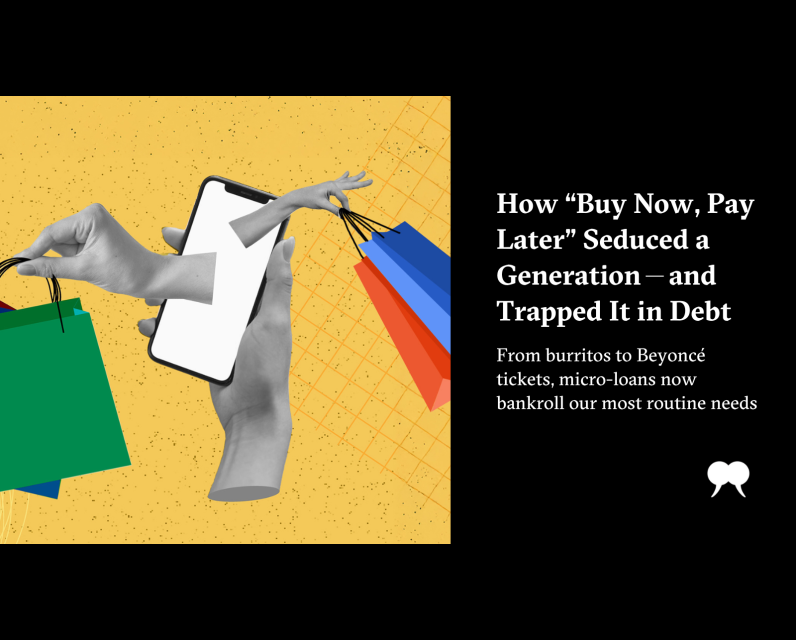How “Buy Now, Pay Later” Seduced a Generation—and Trapped It in Debt

For decades, stores like Leon’s, K Mart, and Zellers offered layaway: a no-interest, pay-in-pieces system where you picked out an item, the store held it, and you chipped away at the cost over weeks or months. Families used it to stretch toward something special—a couch, a TV, Christmas gifts. Eventually, in the 1980s, credit cards took over, and stores grew tired of holding merchandise. But until then, purchases were a pact, a structured ritual of financial restraint. The store trusted that you’d follow through; you trusted that the item would be waiting.
The contours of that pact have since shifted. “Buy now, pay later”—BNPL—programs are a kind of digital layaway but with a twist: you get the reward before fulfilling the commitment. Fintech firms like Afterpay, Flexiti, Sezzle, and Tabit let consumers break down big buys into smaller, more manageable bites. That means you can purchase an item and still defer payment, but now you claim your prize at the point of sale instead of waiting. You can have your cake, eat it, and pay for it eventually.
And people are eating a whole lot of cake. The BNPL payment market in Canada is expected to grow by 12 percent annually to reach $7.5 billion (US) in 2025. The calories haven’t been showing up on our debt waistlines either. In Canada, total consumer debt reached a record high of $2.5 trillion in the fourth quarter of 2024—but BNPL is sometimes referred to as “phantom debt.”
BNPL is essentially a microloan with no credit check. Instead of you buying something, the provider buys it on your behalf. They give most of the money to the merchant but keep a small slice for themselves (compensation for the risk they’re assuming). From the merchant’s perspective, the deal is done, the money is in their pocket, and maybe it’s a sale they wouldn’t have made otherwise. They move on. The providers are left to collect.
Collection involves BNPL firms debiting the money from your account. The consequences are similar to those of other consumer debt: late fees, overdraft charges from your bank, penalty interest, or the potential for your loan to be sold to a third-party collector. Some firms can also lock you out of future loans. Long-term instalment plans may come with the higher interest rates. These arrangements are generally less predatory than payday loans, which inflict exorbitantly high rates. And they aren’t as exploitative as lease-to-own arrangements, in which consumers can end up shelling out two to three times the item’s original price.
Still, BNPL lives in a regulatory grey zone: it is neither a credit card nor a traditional loan. It’s proven popular for a mobile-first generation with a lack of credit history and a desire for instant gratification, because it creates the illusion of low-stakes borrowing. But that convenience can mask real financial fragility. BNPL debt can accumulate invisibly, leaving consumers in the dark until it snowballs. The result is a system that masks risk while amplifying it.
Over a decade ago, Australia’s Afterpay (now owned by Block) helped pioneer the global trend of splitting purchases into four interest-free payments. A company report released in 2023 showed that users—especially younger ones—were drawn to BNPL services for their budgeting convenience and ability to avoid credit card debt.
But what began as a tool for managing occasional indulgences has crept into the fabric of daily life, covering everything from groceries to takeout. Klarna’s partnership with DoorDash, allowing customers to “eat now, pay later,” turned putting a burrito on layaway into a running social media joke. Yet behind the punchlines is something more serious: BNPL is no longer just a convenience. It’s become a coping mechanism for growing financial insecurity. When people start using instalment plans to afford basic necessities, it points to a deeper societal shift.
BNPL is fast becoming the default way to pay for status. Concert venues are now offering split-payment options to make exorbitantly priced tickets more accessible as attendance declines. At this year’s Coachella, about 60 percent of general admission attendees used BNPL to pay for passes, which started around $600 (US). BNPL has become so widespread—and so central to how people shop—that companies now battle for access to the checkout. Sezzle has even filed an antitrust suit against Shopify, accusing it of unfairly limiting competition by making it “extraordinarily difficult” for consumers to choose BNPL options other than Shopify’s own Shop Pay Instalments.
Together, these examples reveal how BNPL has evolved into a shadow credit system that blurs the line between affordability and access—without the accountability or visibility of traditional lending frameworks.
Why are people skipping the grind of saving? Because in today’s economy, patience gets you nowhere. In a world where you can stream a movie in seconds, summon a ride in minutes, and swipe into a date by dinner, the idea of slowly saving up for something—of waiting—feels anachronistic. The culture runs on immediacy. Why should our finances operate any differently? BNPL fits that logic perfectly. It doesn’t just accelerate consumption: it lets people perform prosperity. It offers a way to enjoy the trappings of affluence even when one’s underlying finances are shaky.
We’ve extended that illusion at the policy level: by treating BNPL as a harmless innovation, we’ve delayed real oversight and let the system entrench itself. But BNPL can no longer be conveniently ignored. It’s not a fringe financial tool anymore, and it can’t be explained away by jurisdictional uncertainty. Regulators know that it’s happening, and more and more consumers are relying on it. According to McGill marketing professor Vivek Astvansh, Gen Zers and millennials now make up 72 percent of BNPL users in Canada.
The federal government has taken tentative steps toward recognizing BNPL’s regulatory ambiguity. The Financial Consumer Agency of Canada, which reports to the minister of finance, released a 2021 pilot study on the trend that noted risks like debt accumulation and lack of transparency but stopped short of recommending any changes. Some advocacy groups have urged that BNPL be regulated like other forms of credit, which would require applying affordability checks before lending. While Canada’s 2023 budget pledged to examine rules for instalment loans, it avoided mentioning BNPL by name.
When we’ve taken action on predatory lending, it has been through the Criminal Code, which is one of the only federal policy levers we have to regulate interest rates and lending practices. But any updated rules for small loans, such as the exemption for borrowing under $1,500, don’t capture most BNPL arrangements. That’s because BNPL providers are non-bank lenders, leaving any related provisions up to the provinces.
Last year, then US president Joe Biden’s administration declared that BNPL companies would be considered credit card providers, forcing them to conduct credit checks before lending, but that approach has since been gutted by Donald Trump’s administration. However, a recent announcement is pulling BNPL out of its parallel credit universe: the US credit scoring model, FICO, will incorporate BNPL for the first time this fall. This marks a formal recognition that BNPL is, in fact, a form of credit—with real consequences. The stakes have shifted: missing a payment could now impact your credit score. That shift benefits lenders too. It helps encourage more responsible borrowing and discourages users from taking on more than they can realistically repay.
Similarly, countries like the UK and Australia are moving more quickly toward BNPL legislation, which will offer better protections for consumers who bite off more than they can chew. New laws can ensure that fintech firms don’t profit from people falling behind. Our own deferral is perplexing given that the federal government has signalled that addressing the cost of living is one of its primary priorities. Plus, we usually love to copy other jurisdictions.
Governments themselves haven’t dodged this debt dynamic: they’ve mirrored it. Public institutions are increasingly riding the sugar high of purchasing now and paying later, albeit for good reasons. The 2023 federal budget projected a $40.1 billion deficit, largely due to clean economy investments, and the 2024 fall update anticipated a deficit of $48.3 billion (around 1.6 percent of gross domestic product) due to a mix of new spending commitments, weaker-than-expected revenues, and rising debt interest.
Critics of deficit spending warn that today’s commitments, like the $1.9 billion goods and services tax rebate for first-time home buyers, will become tomorrow’s liabilities, with future taxpayers left to service the mounting interest. In that sense, our national balance sheet isn’t so different from a Klarna cart, only much slower to settle.
On the flip side, BNPL may have something to teach public policy. For instance, why can’t student loans or mortgages be paid off with flat-fee repayment structures? In Canada, federal student loans are interest free, but whether the provincial portion accrues interest depends on where you live. In contrast, Sweden’s student loan system uses income-contingent repayments with clear interfaces and flexible terms—which begins to feel more like Klarna than a bank. In the UK, National Health Service dental costs can be spread across several months with no interest, similarly mimicking the promise of BNPL.
BNPL has exposed both the demand for alternative repayment structures and the shortcomings of legacy public finance tools. Maybe we can take the parts that work—design, flexibility, immediacy—without importing the predatory risk model.
Layaway required restraint and commitment. BNPL has flipped that script, masking real debt accumulation and inflating perceptions of purchasing power. This arrangement does the purchaser few favours by putting them on the hook for payback without having a full picture of their credit worthiness. Every day that we defer regulatory attention to the growing burden of these schemes, the clean-up gets more expensive. One thing’s for sure: we’ll be paying later.
The post How “Buy Now, Pay Later” Seduced a Generation—and Trapped It in Debt first appeared on The Walrus.


Comments
Be the first to comment